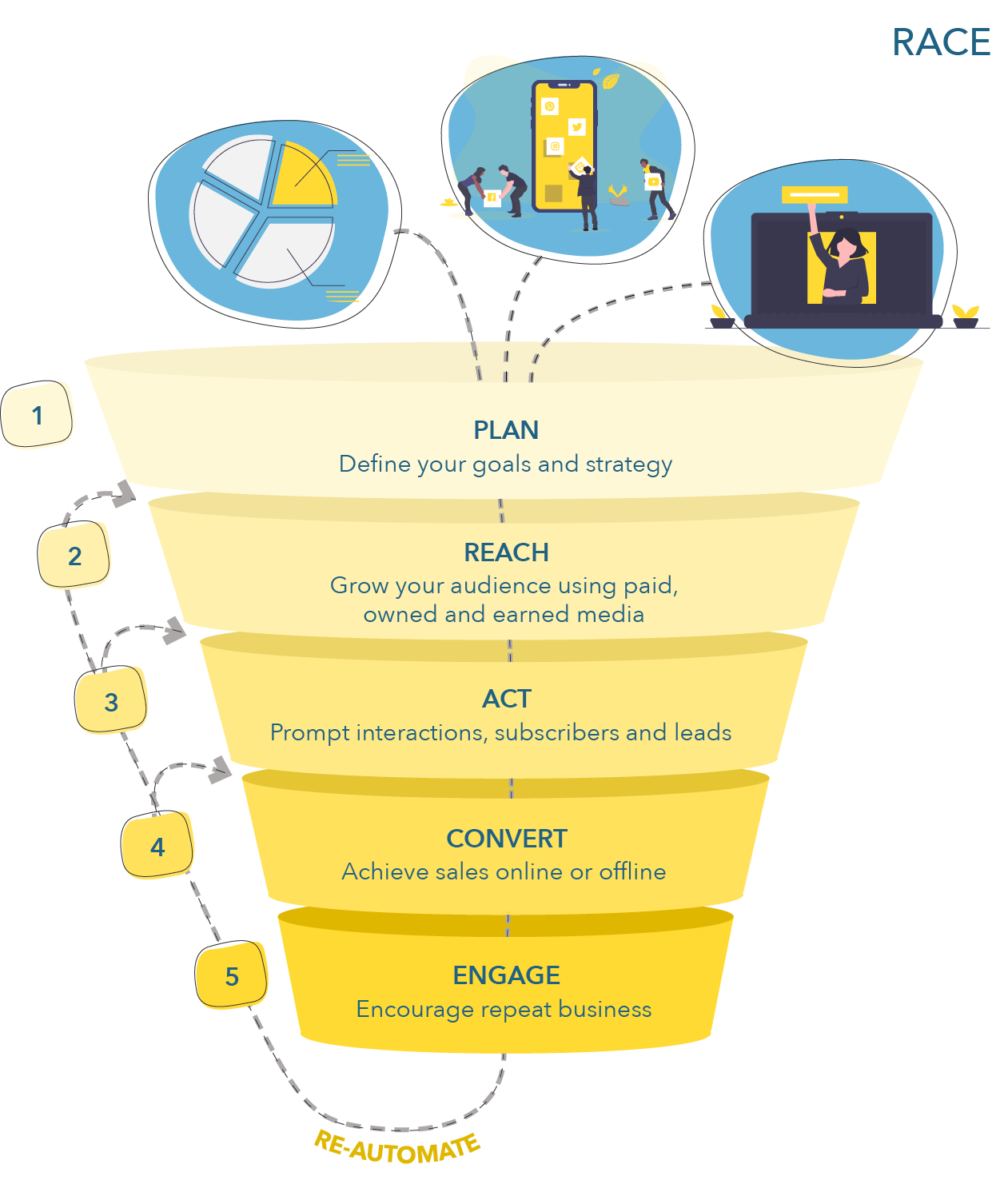RACE for Competitive Analysis
The RACE framework (Figure 4.9; text description) is highly useful in creating a strategy for digital marketing campaigns. It helps answers questions such as the following:
- Reach: How do I bring visitors to my website?
- Act: How do I create a positive user experience? How do I transform visitors into leads?
- Convert: How do I convert leads into customers?
- Engage: Once I have customers, how do I ensure repeat purchases? How can I leverage my customers to participate in my marketing campaigns?
The strategic value of the RACE framework also makes it a great tool to guide competitive analysis. You can turn these questions around to better understand the digital marketing strategy of your competitors:
- Reach: How is my competition bringing visitors to their site?
- Act: Once they have visitors on their web properties, how does do they create positive interactions? How do they transform visitors into leads?
- Convert: How do they convert leads into customers?
- Engage: How do they ensure repeat purchases? How do they foster word-of-mouth and other co-creation activities?
Figure 4.9 RACE

Reach
Understanding how your competitors bring in visitors can be of great use in crafting your own strategy for attracting people to your web properties. Questions to ask include
- How frequently are your competitors running promotions? What benefits do those promotions provide to their customers and potential shoppers, as well as their business?
- Are they running contests online? What kind?
- How are they using their social media channels? How do they drive people from their social media channels to their website?
- What information is included in their marketing banners and callouts?
Act
Similarly, an analysis of your competition should include a better understanding of the user experience on their website. For this stage, you can answer questions such as
- How are they creating positive interactions on their properties and transforming visitors into leads?
- Where are their calls to action throughout the browsing experience? What are the calls to action about?
- Do they have a blog? How frequently do they post? What type of information do they tackle?
- What is the role of content on their website? How does their content differ from yours?
Convert
The next stage is to better understand how your competition converts their leads into customers. To understand this, it is important to take the same steps a customer would: Register for your competitors’ newsletters, understand what happens once a cart is abandoned, and analyze persuasion attempts within webpages. To assist you, questions you should be able to answer include:
- How do they display their products and communicate details?
- How detailed are their product descriptions? What information do they include? What information is missing?
- Where are their calls to action throughout the browsing experience? What are those calls to action about?
- What happens in newsletters? Is there a clear, planned path created to maximize sales? What is that path?
- Do they have an abandoned-cart saver feature? If so, at what point do they send the emails and what are the messages in those emails?
- Is your competition retargeting visitors? Based on what variables?
Engage
To conclude your competitive analysis, become a customer of your competitors! Understand what happens once you buy a product. See whether there exist forums for your competitors’ brands, services, or products. How are consumers of your competitors interacting online? What are your competitors doing to foster such interactions? Here, you can ask
- What happened once you bought a product?
- Do your competitors have some sort of a club? Membership program? Online forum?
- Do they request reviews? Are there consumer-generated content (CGC) campaigns?
- Do they have consumer appreciation campaigns?
- Does their content always talk only to new consumers, or to existing ones as well?
Bringing Competitor Analysis Together
A great approach to try to better understand your competitors is to approach them as you would if you were a persona-related consumer going through the motions of their journey. This is a different logic from evaluating your competition based on other strategic frameworks, such as SWOT. SWOT, indeed, can be used to understand the strengths and weaknesses of your competition as it relates to their digital marketing resources. But never before were we able to analyze exactly how our competitors are operating. Because everything is archived online, and because you can readily have access to marketing efforts such as ads and content, understanding your competitors’ strategic efforts has perhaps never been more accessible. To conclude, to gather as much (targeted) information as possible, be sure to
- subscribe to their newsletter/blog,
- follow them on social media,
- purchase a product, paying attention to packaging, buying experience, and shipping time,
- put an item in your cart and abandon the checkout process,
- check their reviews,
- hunt for their ads,
- follow their publicity, and
- understand their backlinks.

No Comments